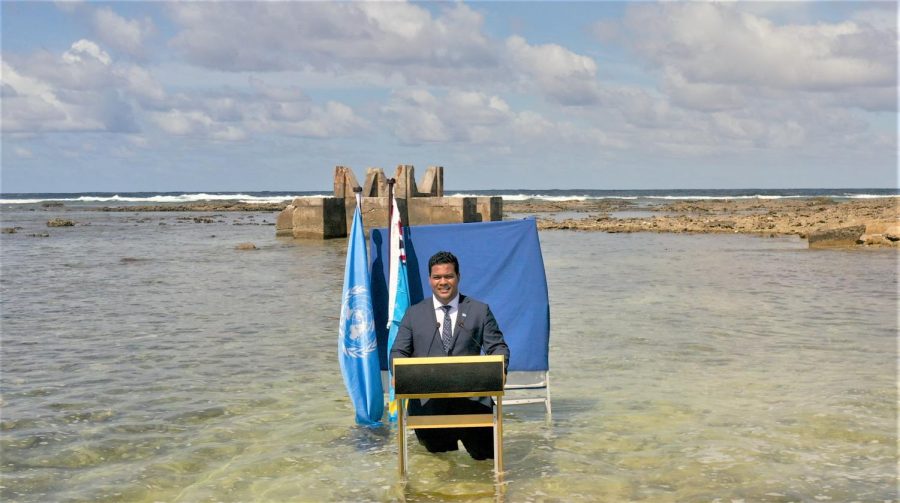Tuvalu becomes the world’s first digitized nation
December 4, 2022
A small island State with a population of 11,000 in the South Pacific will replicate itself in cyberspace. Simon Kofe, Tuvalu’s Foreign Minister, announced that copies of the country’s landscape will be created in the metaverse at the 27th United Nations Climate Change Conference, or COP27, hosted in Egypt in early November. This plan is an attempt to preserve Tuvalu’s culture and history as rising sea levels threaten its physical territory.
Located midway between Hawaii and Australia, Tuvalu is one of the smallest nations in the world, with a total land area of 10 square miles. Its nine islands were settled by Polynesians who migrated from neighboring Samoa in the 14th century, with a smaller number of migrants traveling there from other islands later on. A Spanish explorer named Alvaro de Mendana spotted one of the islands in 1568, becoming the first European to discover Tuvalu. In 1819, Captain Arent de Peyster named one of the atolls “Ellice’s Island” after the ship’s owner Edward Ellice, who would become the eponym for the entire chain of islands.
As the British Empire expanded into the South Pacific, the Ellice Islands became a British Protectorate in 1892, later forming Gilbert and Ellice Islands Colony in 1916. Throughout the 1960s, ethnic tensions emerged between the residents of the two islands, with Ellice people growing wary of being dominated by the Gilbertese. A referendum on separation was held in 1974, with an overwhelming majority of the voters supporting self-determination. Ellice Islands became an independent nation of Tuvalu, with the Gilbert Islands becoming a part of Kiribati.
The geography of Tuvalu has made it extremely vulnerable to global warming. Among the three coral islands and six atolls that make up the country, the highest point is just 15 feet above sea level. The tides at Funafuti, the nation’s capital, have risen by 3.9 millimeters every year, twice as fast as the global average. With the pace of rising sea levels accelerating, many experts believe that the entire country could be submerged within this century.
Other hazards triggered by climate change are also risking Tuvalu’s habitability. Yields of local staples such as taro have plummeted due to the salinization of farmlands. Without rivers on the islands, residents have been fully dependent on rainfall for freshwater, while droughts are wreaking havoc on their already precarious water supply. Frequent storms are also causing massive damage to the nation’s infrastructure. In 2015, Cyclone Pam, the second largest tropical cyclone to occur in the South Pacific Ocean, cost Tuvalu 25 percent of its national GDP that year.
For last year’s COP26 conference, Kofe filmed a speech standing knee-deep in the ocean to show how low-lying Pacific islands are being affected by climate change. At this year’s summit, he revealed plans to create a digital version of the nation. “Our land, our ocean [and] our culture are the most precious assets of our people—and to keep them safe from harm, no matter what happens in the physical world, we’ll move them to the cloud,” he said. The video of his speech was set in a virtual replica of Teafualiku, the island on the northern part of Funafuti.
While the exact timeline has yet to be disclosed, the digital copy of Tuvalu will include its various landmarks. According to Kofe, the aim of the project is more than creating a virtual museum. The government will keep it fully functioning in the metaverse, allowing the nation’s sovereignty and maritime borders to be recognized, even after its physical territory disappears under the ocean.
“I think it’s an interesting idea. If they can replicate Tuvalu entirely in the metaverse, it would probably be one of the best ways to preserve it as a nation,” said University freshman Jude Yurcich. “Otherwise it might be forgotten since it would have no land or presence in the world other than ethnic Tuvaluans.”
Experts are concerned that climate change may leave other Pacific Islands uninhabitable in the coming decades. The Institute for Economics and Peace (IEP), a respected global think-tank based in Sydney, Australia has warned that as many as 1.2 billion people could become climate refugees by 2050. If these grim prospects are materialized, many regions or even nations may have to follow the digital path of Tuvalu.












madeline • Feb 8, 2023 at 8:17 pm
horrific that this is even a concept but it seems like a pretty smart use of ubertechnology for the good of humanity… hopefully. you used the exact word for it: grim